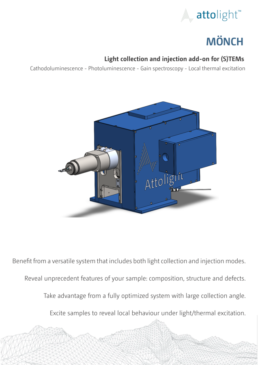Mönch
Light Collection / Injection for STEM
Cathodoluminescence – Photoluminescence –
Thermo-emission – Compatiblity with EELS, EDS…

The Mönch add-on is a unique tool that can operate in either a light collection or light injection mode, thanks to its specific mirror design. In addition, the flexibility of the add-on allows an external coupling either in free space or via an optical fiber.
In light collection mode, the Mönch add-on has been designed to achieve an unprecedented signal-to-noise ratio thanks to:
- A proprietary collection mirror with a curvature radius that fits in a small pole piece gap (down to 5mm) and a precise sub-micrometer alignment for a perfect adjustment of the mirror with respect to the sample.
- A working distance reduced to 300µm to optimize light collection efficiency
- A patented asymmetric optical fiber designed to preserve brightness and spectral resolution.
In light injection mode, an unprecedented level of performance is reached thanks to:
- A beam size reduced to few microns for localized excitation of your samples. Light injection can be operated to locally heat specific areas of the sample surface.
- The ability to perform injection and light collection measurements simultaneously.
| Mode | Excitation source | Analysis (detection) |
|---|---|---|
| Light collection Light collection after surface excitation |
E-beam, Laser, Thermal, Electrical… | Cathodoluminence (light) |
| Light injection Electron imaging after light/thermal excitation |
Laser, other sources of light | Electron imaging (electron) in photo emission/thermo-ionic regimes |
| Light injection + collection Light emission after light/thermal excitation |
Laser, other sources of light | Photoluminesence (light) |
The Mönch is an add-on system connected to a TEM. A retractable arm holds a proprietary reflective mirror to collect or inject light on the sample.
Mirror independent from sample holder
- Flexibility, ease of alignment vs. e-beam and sample
- Free sample displacement (enables to scan a large sample surface)
- High curvature parabolic mirror (NA>0,4)
Motorized arm (X travel 30mm)
- Fine alignment (precision better than 100nm)
- Full retractation arm to enable EDX, EELS, 4D-STEM… analyses
Low mirror-sample distance
- Maximize light collection/injection
- Spot size down to 2µm-diameter
High mirror reflection
- Up to 90% from 200nm to nIR.
- Various mirror coatings available (ex: Gold coating for l>1.7µm)
Optimized module
- User-proof actuation system with absolute encoders (position recovered after power cut-off without need for calibration)
- Stage touch alarm
- Compatible with 120°C system vacuum bakeout
- Compatible optical fiber or free space (switch takes few seconds)
Collection mode
- Free space or through a fiber
Patented asymmetric fiber
- Fibers arrangement parallel to the entrance slit of the imaging spectrograph
- Brightness and spectral resolution are preserved
- Study of advanced materials, such as:
- Nitrides (GaN, InGaN, AlGaN, …);
- III-V (GaP, InP, GaAs, …);
- II-VI (CdTe, ZnO, …)
- Wide band-gap materials (diamond, AlN, BN)
- Compositional inhomogeneities in compound materials (e.g. Indium clustering in InGaN)
- Confined structures or heterostructures morphology to their optical properties
- Defects (vacancies, threading dislocations, stacking defaults, …)
- Plasmonics …
Application
Application notes
Semiconductors:
- InGaN nanowires with high InN molar fraction: growth, structural and optical properties, X . Zhang, H. Lourenço-Martins, S. Meuret, M. Kociak, B. Haas, J.-L. Rouvière, P. H. Jouneau, C. Bougerol, T. Auzelle, D. Jalabert, X. Biquard, B. Gayral, and B. Daudin, Nanotechnology, 27, 195704 (2016). https://iopscience.iop.org/article/10.1088/0957-4484/27/19/195704
- Nanometer-scale monitoring of quantum-confined Stark effect and emission efficiency droop in multiple GaN/AlN quantum disks in nanowire, L. F. Zagonel, L. H. G. Tizei, G. Z. Vitiello, G. Jacopin, L. Rigutti, M. Tchernycheva, F. H. Julien, R. Songmuang, T. Ostasevicius, F. de la Peña, C. Ducati, P. A. Midgley, and M. Kociak, Physical Review B, 93, 205410 (2016).
https://journals.aps.org/prb/abstract/10.1103/PhysRevB.93.205410
Time-resolved CL
- Time-Resolved Cathodoluminescence in an Ultrafast Transmission Electron Microscope, S. Meuret, L. H.G. Tizei, F. Houdellier, S. Weber, Y. Auad, M. Tence, H.-C. Chang , M. Kociak and A. Arbouet, Cond. Matter, arXiv:2105.11401 (2021)
https://arxiv.org/abs/2105.11401
Monolayers
- Nanoscale modification of WS2 trion emission by its local electromagnetic environment, N. Bonnet, H.Y. Lee, F. Shao, S. Y. Woo, J.-D. Blazit, K. Watanabe, T. Taniguchi, A. Zobelli, O.Stephan, M. Kociak, S. Gradecak-Garaj, L. H. G. Tizei, arXiv preprint arXiv:2102.06140, 2021.
https://arxiv.org/abs/2102.06140 - Monolayer and thin h–BN as substrates for electron spectro-microscopy analysis of plasmonic nanoparticles, Luiz Henrique Galvão Tizei, Hugo Lourenço-Martins, Pabitra Das, Steffi Y. Woo, Leonardo Scarabelli, Christoph Hanske, Luis M. Liz-Marzán, Kenji Watanabe, Takashi Taniguchi, Mathieu Kociak, Appl. Phys. Lett. 113, 231108 (2018).
https://doi.org/10.1063/1.5054751
Plasmonics
- Probing plasmonic excitation mechanisms and far-field radiation of single-crystalline gold tapers with electrons, R. Lingstadt, N. Talebi, S. Guo, W. Sigle, A. Campos, M. Kociak, M. Esmann, S. F. Becker, E. Okunishi, M. Mukai, C. Lienau and P. A. van Aken, 2020 Phil. Trans. R. Soc. A.37820190599.
http://doi.org/10.1098/rsta.2019.0599 - Mapping plasmons at the nanometer scale in an electron microscope, M. Kociak, M. & O. Stéphan, Chemical Society Reviews, 43, 3865–3883 (2014).
https://doi.org/10.1039/C3CS60478K
Updated list of scientific references can be find here : https://attolight.com/scientific-references/



